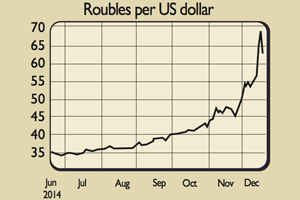
“Even by the standards of emerging market currency meltdowns, the rouble’s gyrations… have been extreme,” said the Financial Times. Less than a fortnight ago, 52 roubles were needed to buy a US dollar; by last Tuesday you needed 70-80, despite a huge 6.5% overnight interest-rate hike by the central bank to stop capital flooding out of Russia.
It bounced back on Wednesday as the Russian central bank outlined plans to help ease pressure on the banking system, although the rouble remained above the 60 mark.
What the commentators said
Russia is facing a “perfect storm”, said Timothy Heritage on Reuters. The oil-price slump exposed its failure to diversify during the commodities boom. Oil and gas account for over two thirds of Russia’s exports. The crisis in Ukraine and subsequent sanctions have also undermined confidence in the rouble.
Higher interest rates designed to stop capital flight are simply squeezing the economy, while the jump in inflation, already at 9%, is eroding real incomes. As the currency rout intensifies, “a lethal combination of deep recession and runaway inflation” becomes more likely, said The Economist.
A key problem is Russia’s external debt of around $614bn, and it is becoming increasingly hard to borrow abroad thanks to the sanctions.
“The blurred line between the state and Russian firms means the Kremlin may end up on the hook” for much of this, continued The Economist. “No wonder confidence in the prop provided by the Kremlin’s foreign-exchange reserves” – around $370bn – is dwindling.
Russia could impose capital controls. But this would be “a deeply unpopular and retrograde step” for a government that worked so hard to boost confidence in the rouble in the 2000s, said the FT. Only a loosening of Western sanctions or sharply higher oil prices, said Pierre Briancon on breakingviews.com, can stem the tide now.